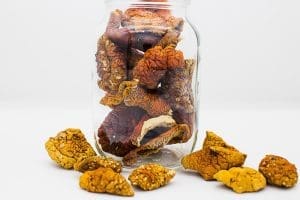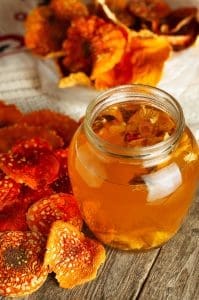Decarboxylating Amanita Muscaria Makes for a Smooth Experience
The Amanita Muscaria mushroom, with its vibrant red cap and iconic white spots, has captivated cultures for centuries. Known for its rich history in rituals, folklore, and traditional medicine, this mushroom isn’t just visually striking, it also carries powerful psychoactive properties.
However, consuming raw Amanita Muscaria comes with risks. The mushroom contains ibotenic acid, a compound that can lead to nausea, overstimulation, and other unpleasant effects. To fully experience the mushroom’s calming and euphoric benefits, it must undergo a chemical transformation known as decarboxylation.
Understanding how to decarboxylate Amanita Muscaria is essential for reducing ibotenic acid and converting it into muscimol—the compound responsible for the mushroom’s relaxing and mood-enhancing effects. This process requires careful temperature control and precise preparation to ensure both safety and potency.
With proper decarboxylation, Amanita Muscaria becomes a reliable option for those seeking relaxation, improved sleep, or stress relief, offering a more predictable and enjoyable experience.
What is Decarboxylation?
Decarboxylation is a chemical process that removes a carboxyl group (-COOH) from a molecule, releasing carbon dioxide (CO₂) in the process. In the context of Amanita Muscaria mushrooms, this transformation is crucial for converting ibotenic acid—a compound known for its potential to cause nausea, overstimulation, and discomfort—into muscimol, the more desirable and stable compound responsible for the mushroom’s calming and euphoric effects.
Unlike psilocybin-containing mushrooms, which rely on enzymatic processes in the body to activate their psychoactive compounds, Amanita Muscaria requires external heat application to trigger decarboxylation effectively. This heat-based process breaks down the ibotenic acid structure, removing its excitatory properties and enhancing muscimol’s soothing effects.
The Science Behind the Transformation
- Ibotenic Acid: Naturally present in raw Amanita Muscaria, this compound can cause unwanted side effects, such as nausea, dizziness, and overstimulation, when consumed in large amounts.
- Muscimol: Through decarboxylation, ibotenic acid loses its carboxyl group and transforms into muscimol. This compound interacts with GABA receptors in the brain, leading to effects like relaxation, reduced anxiety, and altered states of perception.
Proper decarboxylation ensures that ibotenic acid is minimized, reducing adverse effects while maximizing the desired psychoactive and therapeutic properties of muscimol.
Controlling temperature and duration during this process is essential. Excessive heat can degrade muscimol, reducing its potency, while insufficient heat may leave too much ibotenic acid behind, increasing the risk of side effects. Understanding the science of decarboxylation is the foundation for safely preparing Amanita Muscaria and unlocking its full potential.
The Key Compounds in Amanita Muscaria
The psychoactive properties of Amanita Muscaria stem from two primary compounds: ibotenic acid and muscimol. These chemicals work in tandem, with one acting as a precursor to the other through the process of decarboxylation.
Ibotenic acid is naturally present in raw Amanita Muscaria mushrooms and is known for its excitatory effects on the nervous system. While it can produce psychoactive effects, it is also associated with nausea, dizziness, overstimulation, and discomfort when consumed in large quantities. This compound interacts with NMDA receptors in the brain, contributing to its stimulating and often unpredictable effects.
When Amanita Muscaria undergoes decarboxylation, ibotenic acid transforms into muscimol, a more stable and desirable compound. Muscimol primarily interacts with GABA receptors, which play a crucial role in regulating mood, relaxation, and neurological activity. This interaction results in effects such as euphoria, reduced anxiety, enhanced calmness, and mild sensory alterations.
Decarboxylation is essential because it minimizes the presence of ibotenic acid, reducing the likelihood of adverse effects while maximizing the psychoactive and therapeutic benefits of muscimol. Without this transformation, the consumption of Amanita Muscaria can lead to an unpredictable and potentially uncomfortable experience.
Understanding the roles of ibotenic acid and muscimol highlights why careful preparation and proper heat application are critical steps in unlocking the mushroom’s full potential. Both compounds have distinct properties, but only through decarboxylation can Amanita Muscaria deliver its calming and euphoric effects reliably.
Methods for Decarboxylating Amanita Muscaria
Decarboxylating Amanita Muscaria converts ibotenic acid into muscimol, reducing side effects and enhancing its calming properties. Two reliable methods are commonly used: oven decarboxylation and the water bath method.

In oven decarboxylation, finely chopped mushrooms are spread on a parchment-lined baking sheet and heated at 190–200°F (88–93°C) for 30–60 minutes. This method is quick and effective but requires close temperature monitoring to prevent overheating, which can degrade muscimol.
The water bath method involves placing chopped mushrooms in a heatproof bag or jar and submerging them in gently simmering water at the same temperature range (190–200°F) for 1–2 hours. While more time-consuming, this approach offers stable, consistent heat, reducing the risk of potency loss.
Both methods are effective when temperature and duration are carefully managed. The oven method is faster and convenient, while the water bath provides gentler heat control. Choosing the right approach depends on available tools and preference, but precision and patience are key to successful decarboxylation.
Ideal Temperatures and Times for Decarboxylation
For effective decarboxylation of Amanita Muscaria, maintaining the right balance of temperature and time is essential:
Temperature: 190–200°F (88–93°C)
Duration: 30–60 minutes (oven) or 1–2 hours (water bath)
Temperatures above this range can degrade muscimol, reducing potency, while lower temperatures may leave excessive ibotenic acid, increasing unwanted side effects. Consistency is key to achieving safe and reliable results.
Safety Precautions During Decarboxylation
Proper safety measures are essential when preparing Amanita Muscaria to minimize risks and ensure a smooth experience.
- Ensure Proper Ventilation: Work in a well-ventilated area to prevent inhaling any vapors released during heating.
- Use Protective Equipment: Wear gloves and, if possible, a mask when handling raw mushrooms to reduce skin or respiratory irritation.
- Monitor Temperature Closely: Avoid exceeding 200°F (93°C) to prevent degrading muscimol or creating harmful byproducts.
- Handle Mushrooms Carefully: Use clean tools and surfaces to prevent contamination during preparation.
- Start with a Small Dose: After decarboxylation, begin with a low dose (0.5–1g) to gauge individual tolerance before increasing intake.
- Store Safely: Keep decarboxylated mushrooms in an airtight container in a cool, dry place, away from children and pets.
Following these precautions helps ensure that Amanita Muscaria is prepared and consumed as safely as possible, allowing for a more predictable and enjoyable experience.
How to Use Decarboxylated Amanita Muscaria

Once Amanita Muscaria has been properly decarboxylated, it can be consumed in several ways, depending on personal preferences and desired effects. Each method offers a unique experience while allowing users to benefit from the mushroom’s calming and euphoric properties.
Tea: Steeping decarboxylated Amanita Muscaria in hot water creates a soothing herbal tea. This method allows for slow and steady absorption, offering a gentler onset of effects. Adding honey or herbs can enhance flavor and complement the experience.
Tinctures: Alcohol-based tinctures are another popular option, offering precise dosing and long shelf life. Decarboxylated mushrooms are soaked in high-proof alcohol to extract the active compounds, creating a concentrated liquid form that can be taken sublingually or mixed into drinks.
Edibles: Incorporating Amanita Muscaria into foods like chocolates, honey, or baked goods provides an enjoyable and discreet way to consume. When added to recipes, decarboxylated mushrooms distribute evenly, allowing for consistent dosing in each serving.
Dosage Recommendations
For beginners, it’s recommended to start with 0.5–1 gram of decarboxylated Amanita Muscaria and wait at least two hours before considering additional intake. The effects can vary based on individual body chemistry, preparation methods, and consumption style.
Each method offers a unique pathway to experiencing Amanita Muscaria’s potential benefits, whether the goal is relaxation, sleep support, or mild sensory enhancement. Choosing the right consumption method depends on personal preference and the desired intensity of effects.
Unlock the Full Potential of Amanita Muscaria with Proper Preparation
Decarboxylation is an essential step in preparing Amanita Muscaria for safe and effective use. By carefully converting ibotenic acid into muscimol through controlled heat, this process reduces unwanted side effects and enhances the mushroom’s calming and euphoric properties.
Whether using the oven method for efficiency or the water bath method for precision, maintaining the correct temperature and timing is crucial to achieving consistent results. Alongside proper safety precautions and responsible dosing, decarboxylated Amanita Muscaria can provide a reliable and enjoyable experience.
At ShroomBuddy, we are here to support your journey with a carefully curated selection of high-quality mushroom products designed for consistency, reliability, and enjoyment. Not sure where to start? Reach out to the ShroomBuddy team to find the perfect match for your wellness needs.
